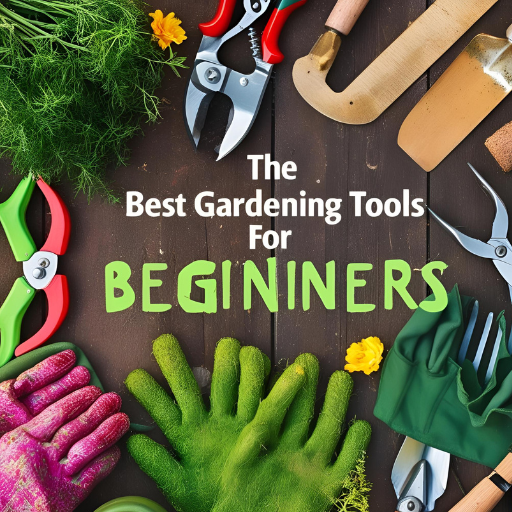Gardening is not just a relaxing and rewarding hobby—it’s also a skill that becomes much easier and more enjoyable when you have the right tools at hand. If you’re just starting your gardening journey, this guide will walk you through the most essential tools every beginner gardener should own, how to use them, and tips for choosing quality items that will last.
Why the Right Gardening Tools Matter
Using proper gardening tools not only makes your work easier and more efficient, but it also helps protect your plants and prevents injury. From preparing the soil to planting, watering, pruning, and maintaining your garden, each task becomes smoother with the right equipment. For beginners, investing in a small but effective toolkit can significantly boost your confidence and success.
1. Gloves: Your First Line of Defense
Never underestimate the power of a good pair of gardening gloves. They protect your hands from thorns, blisters, cuts, and even harmful chemicals in fertilizers or insecticides.
What to Look For:
-
Durability: Look for gloves made from leather or synthetic leather for heavier work.
-
Flexibility: Ensure they allow you to move your fingers freely.
-
Breathability: Especially if you garden in hot climates.
2. Hand Trowel: The Swiss Army Knife of Gardening
This small but mighty tool is essential for planting, transplanting, digging small holes, and removing weeds. It’s incredibly versatile and should be part of every beginner’s toolkit.
Pro Tips:
-
Choose one with a stainless steel blade to avoid rust.
-
A comfortable, ergonomic handle will help reduce hand fatigue.
3. Pruning Shears: For Healthy Plants
Also known as secateurs, pruning shears are crucial for trimming and shaping plants, removing dead growth, and harvesting fruits or herbs.
How to Choose:
-
Look for sharp, high-quality blades.
-
Bypass pruners are best for live plants, while anvil pruners work well for dead branches.
4. Watering Can or Hose: Keeping Your Garden Hydrated
Water is life for your garden. A good watering system ensures your plants get what they need without wasting water or damaging fragile leaves.
Considerations:
-
A long-spouted watering can gives more control.
-
Soaker hoses or drip irrigation are excellent for larger gardens.
5. Garden Fork: For Breaking Up Soil
A garden fork helps turn soil, mix in compost, and break up compacted earth. It’s especially useful if you’re working with clay or rocky soil.
Buying Tips:
-
Stainless steel tines resist bending.
-
Look for one with a sturdy handle and comfortable grip.
6. Spade: The Power Digger
A spade is a flat-bladed shovel used for digging, edging beds, lifting sod, and more. It’s ideal for more heavy-duty tasks than a hand trowel can handle.
Choose Wisely:
-
Square blades are great for edging.
-
D-handles can offer better control and leverage.
7. Rake: For a Clean and Clear Garden
Rakes help with clearing leaves, leveling soil, and removing debris. There are two main types:
-
Leaf rakes (fan-shaped) for light debris.
-
Garden rakes (stiff and straight) for heavier soil and debris.
8. Wheelbarrow: For Hauling Made Easy
Even in a small garden, a wheelbarrow helps you carry soil, mulch, compost, and tools around efficiently. It saves your back and time.
Look for:
-
Pneumatic tires for easier maneuvering.
-
A rust-proof tray if you’ll store it outdoors.
9. Hoe: For Weed Control
Hoes are excellent for weeding and cultivating soil. A basic hoe can help you stay ahead of unwanted plants without using chemicals.
Varieties:
-
Draw hoes for pulling weeds.
-
Scuffle hoes for surface weeding between rows.
10. Garden Kneeler or Pad: Protect Your Knees
Gardening often requires kneeling, which can strain your knees and back. A garden kneeler or foam pad offers comfort and support.
Bonus Tip:
Some kneelers double as stools and have tool storage!
Tips for Buying Gardening Tools as a Beginner
Before you rush to the nearest store or online shop, keep the following in mind:
1. Start Small
You don’t need everything at once. Begin with the basics and expand as you learn what you actually need.
2. Invest in Quality
While it’s tempting to buy cheap tools, low-quality items often break easily. It’s better to buy fewer, higher-quality tools that will last.
3. Read Reviews
Before purchasing, check online reviews or ask for recommendations from other gardeners.
4. Maintain Your Tools
Clean them after use, oil metal parts, and store them properly to extend their lifespan.
Optional Tools to Consider as You Advance
As you become more experienced, you may want to add:
-
Soil testers
-
Plant labels
-
Garden scissors
-
Compost bins
-
Raised bed kits
Final Thoughts: Your Toolkit Grows With You
Gardening is a journey, and your tools will grow and evolve with you. Starting with the right basics allows you to work more efficiently, enjoy the process, and avoid unnecessary frustration. With just a few high-quality tools, you can take your first steps into the gardening world with confidence and excitement.
